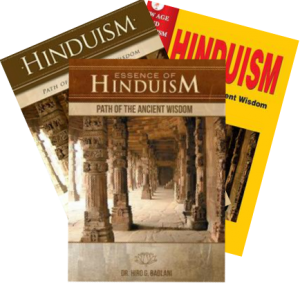For Hindus, scriptures have most powerful influence in everyday life: “The man who rejects the words of the scriptures and follows the impulse of desire attains neither his perfection, nor joy, nor the Path Supreme. Let the scriptures be, therefore, thy authority as to what is right and what is not right.” (Bhagavad Gita, 16: 23–24). The spiritual richness of the ancient Hindu scriptures is simply unmatched, but the volume of these scriptures is even more amazing. The very first scriptures were the four Vedas. These scriptures comprise the divine revelations, the Shrutis. As such, they have been considered the basis and command of Hinduism. The Upanishads, which are the essence and final culmination of the Vedas, also form part of the Shruti scriptures.
Two great epic scriptures, the Ramayana and the Mahabharata, soon followed the Vedas/Upanishads. Yoga Vasistha, also attributed to Rishi Valmiki, is part of Ramayana. These scriptures and others that followed were formed as Smritis, the ones that were remembered. The Vedic scriptures had a strict code of finality. The Smriti scriptures of the later period had no such compulsions. One example may explain: Vedas teach that no violence be done to any being. This, however, would prove to be an impossible position in certain circumstances. The Smriti scriptures, on the other hand, encouraged modifications as the situation demanded, according to place and time. Smriti scriptures are derived from human experience and are the bedrock of tradition, continuing from the ancient and into modern. The Smriti scriptures may be varied according to the sect (sampradaya), and may be written in languages other than Sanskrit.
The earliest written script for the Hindu scriptures was the Vedic Sanskrit Brahmi, as early as the seventh century BCE. Classical Sanskrit, which is also associated with the proto-Indo-European languages and is considered the mother of many Indian as well as European languages came to become prominent in fourth century CE. It adapted the present Devnagri script in the tenth century CE. It is said that Sanskrit is phonetically the most accurate language. Its grammar is also most correctly built. Its constitution was so perfect that no word could have any variation of pronunciation or meaning and denotation. Each syllable (akshara) in the Vedas is endowed with significance and purpose, imparting to it a cosmic energy in a spiritual manner. Many experts suggest that it would be the most ideal language for computer technology.11 Says Swami Vivekananda, “The vast ancient literature of India was written in Sanskrit, which was never a spoken language! It was only used for writing the scriptures, epics, and dramas, etc.”12 It thus became truly a classic language of India. In the absence of paper, the ancient Hindu scriptures were originally written on dried palm leaves. Sir William Jones first established its relationship with other European languages in 1789.13
Different ethnic groups, however, retained much of their original linguistics and folklore, apart from influencing the mainstream Sanskrit. India today has nearly thirty languages and over five hundred dialects in use. All these languages originated from four important groups: Austro-Asiatic, Tibeto-Burman, Dravidian, and Indo-Aryan. The earliest was the Austro-Asian, which group passed by the Indian subcontinent from Africa on its way to Australia about fifty thousand years ago.14 (and probably even earlier-See Chapter Roots of Hinduism in the Ancient Cultures of India) In the long history of existence—over six million years—mankind perhaps began the journey of writing only around five thousand years ago or little earlier!
Apart from the Ramayana and the Mahabharata, the Smritis recognize a number of other important texts. The Bhagavad Gita, which forms a part of the Mahabharata, is considered the authoritative vehicle of Hinduism and its philosophy. The Dharma Shastras are specialized manuals that deal with different subjects such as law, politics, and economics. Manu Smriti, the Book of Manu, gives exhaustive details of the codes of conduct for all occasions. Even though there now may be some areas of disagreement, this treatise has long held its powerful influence in framing the laws for Hindu society. Manu, who is the mythological son of Lord Brahma, is thus considered the origin of mankind in Hindu philosophy. Manu literally means “thinking mind” and is therefore regarded as the symbolic beginning of higher thinking in human beings.
Niti Shastra, written by a clever prime minister of the Maurya dynasty named Chanakya (329–297 BCE), has been hailed as an authoritative treatise on politics and administration. Artha Shastra and Kautilya Shastra deal with economics, law, politics, and the like. Vastushastra, Hindu science of architecture, gives details of construction activity, and is closely associated with thousands of ancient as well as modern Hindu temples.
The Darshanas are texts that explain and comment on the main Vedas/Upanishads:
The Sankhya
The Purva Mimamsa
The Uttara Mimamsa or Brahama Sutra
The Yoga Sutra
The Nyaya
The Vaisheshika
Different philosophies do not reflect opposing views. More likely, they portray different aspects of Hindu theology, complementing each other to present the full picture.
Apart from these different philosophical codes, there was yet another one: The Charvaka philosophy, which has been known as Hindu materialism. It is a philosophy that promotes pleasure seeking and is contrary to the Vedic teachings. Even though this philosophy was never accepted by mainstream society, its existence and endorsement without any serious opposition indicates the extent of freedom of opinion in Hindu culture.
Agamas are the Smriti scriptures that were written as operating instructions for Hindu worship in the three main sects of Hindu faith. These scriptures are the manuals for the construction of temples and installation of the idols, and for conducting various rituals, worship ceremonies (pujas), and festivals. Some consider Agamas also as Shrutis.
There are three different sets of these scriptures:
Shaiva Agamas—worship of Lord Shiva
Vaishnava Agamas—worship of Lord Vishnu
Shakti Agamas—worship of many goddesses
Puranas literally means ancient. The Puranas have been described as the Vedas of the common man. The complex language used in earlier scriptures has been substituted with simpler and easy-to understand descriptions. Hindu sages described the ancient tales and allegories in mythological style so that the ordinary person could understand the deep spiritual philosophy in a simple manner of faith and devotion. The Vedic concept of a formless and transcendental God was substituted by various images of the Divine, which could be more easily comprehended by the common person. Spiritual transformation through devotion (bhakti) became more popular in these scriptures. These scriptures also cut across the barriers of the caste system, as all sections of the society had access to them. There are a total of eighteen Puranas, in which the intricate philosophies are explained very candidly in tales and parables. Six Puranas each are dedicated to Lord Brahma, Lord Vishnu, and Lord Shiva.
It is through the Puranas that many Hindu religious practices like murti-puja (idol worship), shradha (worship ritual to propriate one’s ancestors), varna dharma (religious ceremonies associated with different social categories) etc. have been properly explored. Puranas also contributed significantly toward the temple building activity. The exact date of the Puranas is not known, but it is likely to be in the early centuries of the Common Era. Amongst the Puranic scriptures, Srimad Bhagavad occupies a very special place in Hindu society. Few passages in the Puranic scriptures have been considered inappropriate. Some modern Hindu swamis have urged followers to ignore such writings and pay more attention to the real spiritual teachings.15
Panchatantra (five books)—a wise sage Vishnusharma wrote these scriptures around 200 CE. These scriptures contain stories of animals, through which human weaknesses and vices were portrayed very effectively. These books have now become popular for teaching children about morality.
Tantra—the Tantra scriptures are mostly dedicated to the Shakta philosophy of Hinduism, although there are also separate Saiva and Vaishnav scriptures of this tradition. There are sixty-four Tantra texts, which were written in the middle part of the first millennium and later.16 These texts are devoted to many techniques, which have been formulated to invoke spirituality and divinity in man. Some of these Tantra techniques, like Kriya yoga and Kundalini yoga, have gained popularity in many different parts of the world, apart from India. The other aspect of the Tantra philosophy, however, in which the primordial energy is aroused by the practice of sexual techniques, partaking of meat and wine, and dubious methods of black magic, has been seriously questioned by many and has now become taboo mostly.
Commentaries on Hindu scriptures written later by Shankaracharya (700–740 CE), Ramanujacharya (1017–1137 CE), and Madhvacharya (1199–1278 CE) also must be mentioned for their great merit in relation to the ancient Hindu philosophy.17
There are many more supplements, commentaries, and manuscripts in other ancient languages, such as Pali, Tamil, and some regional languages. Most prominent among these are Tirukural and allied Tamil scriptures. Tirukural was written in the first century BCE and is regarded as the Holy Bible of Saivites. Tirukural, however, hailed the Vedas as the most superior spiritual guidelines.
If written word is any indicator of the level of civilization, the old Hindu scriptures certainly project a glorious and shining portrait of the culture of India during the ancient period. No wonder that ancient India became the chief hub of education. The first university in the world was established in Takshila in 700 BCE, where scholars from many other countries would come for higher studies. The University of Nalanda in the fourth century CE was one of the greatest achievements in the field of education in Hindu civilization. The ancient philosophy of India, the legacy of prehistoric oral tradition, also gave birth to the Sramana ideology of renunciation and meditation, which attracted scholars from many countries.18 It is even probable that the Greek masters Plato (427–347 BCE) and Aristotle (385–322 BCE) had contact with Hindu teachings.19
Hindu scriptures have continued to grow till date; the important teachings of the most exalted seers have been regarded as the minor Upanishads as compared to the original major Upanishads, which were compiled before the Buddhist era (500BCE).
Hinduism does not have only one scripture as the sole authority; rather, there have been innumerable scriptures, each depicting its different ideas and viewpoints. This free flow of spiritual literature from a very early age provided abundant scope to change and modify itself, keeping up with time, circumstances, and individual aptitudes. Yet, the essential principles of the Vedas and Upanishads remained untouched. Different ethnic races and tribal groups that amalgamated toward what later became the Hindu religion were allowed to retain their individual identity to a very considerable extent. This freedom of thought and belief has remained the sheet anchor of Hindu theology over millennia, and has contributed immensely toward its evolution.




